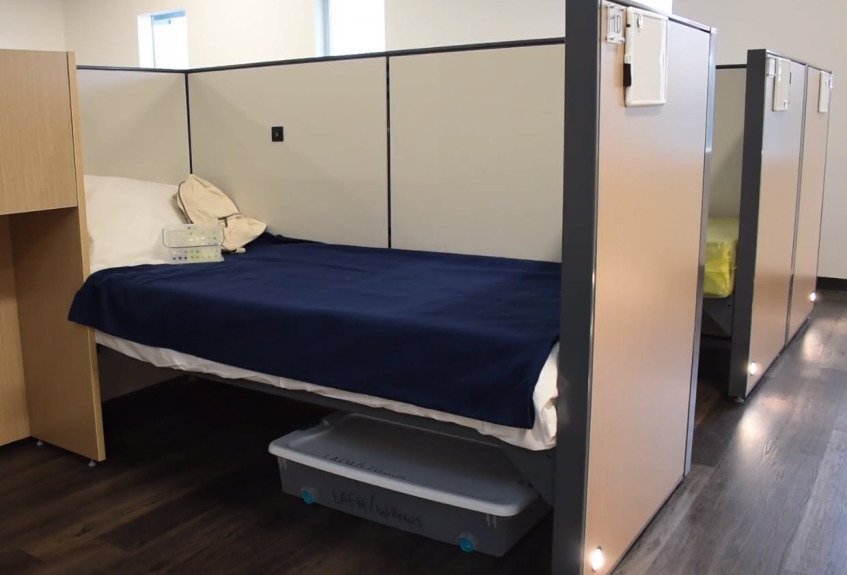
Canoga Park shelter is first of new wave of efforts to help homeless in west San Fernando Valley This part of the Valley, west of the I-405 freeway, has long been short on shelter space, leaving many people who find themselves homeless in this area to look to the east San Fernando Valley and other […]

The west San Fernando Valley hit a milestone on Friday, Feb. 12, with the grand opening of a temporary shelter that is expected to bring more than 80 people experiencing homelessness in from the streets.
This part of the Valley, west of the I-405 freeway, has long been short on shelter space, leaving many people who find themselves homeless in this area to look to the east San Fernando Valley and other parts of the city for shelter and services. Many end up setting up makeshift shelters of their own, often along train tracks, busways or the Los Angeles River.
The Willows, a 75-bed shelter that was converted from a former county mental health building in Canoga Park, could begin to change that, along with several other projects that the councilman for the area, Bob Blumenfield, said Friday are also on the way for his southwest Valley district, including a safe-parking site and two cabin communities.
Operated by the nonprofit LA Family Housing, The Willows began as a county shelter project that was proposed about two years ago, and has since been incorporated as part of a city initiative, known as A Bridge Home, that was launched two years ago by Los Angeles Mayor Eric Garcetti.
As of the end of Friday, around 40 people will have moved into the new shelter, according to LA Family Housing President Stephanie Klasky-Gamer, whose nonprofit is operating the facility. And in another milestone, some of them will be coming in as couples.
In a virtual ribbon-cutting event Friday that was streamed over Facebook amid the COVID-19 pandemic, Los Angeles County Supervisor Sheila Kuehl put special emphasis on The Willows being the first one in the city to allow couples.
She explained that in the past, with many shelters designated as either men-only or women-only, heterosexual couples who are offered shelter space face the decision of whether to split up, in terms of where they reside. And if both men and women are permitted to enter the same shelter, they often would have to stay in separate sections. That often makes decisions about entering a shelter all the more difficult, Kuehl said.
“So would you in that moment of incredible vulnerability actually leave the person you cherish and need most in your life for an interim housing bed,” she said.
A similarly significant obstacle for many has been rules that restrict people from bringing their pets into shelters. Now, many shelter developers plan for pets to move in with their owners, and incorporate small, pet-friendly features into their blueprints. The Willows has an area for residents to bathe their pets.
Many shelters similar to The Willows that have opened in the past two years incorporate changes aimed at correcting past practices that may have prompted many to choose the streets over being sheltered inside. This has also come with a change in terminology for how to refer to the facilities. This new generation of shelters are more often referred to “interim housing,” a distancing from the word “shelter,” which has negative connotations shelters for many people experiencing homelessness.
Even with these improvements, the evolving effort to help unhoused neighbors seems to continue hitting speed bumps.
While public officials gathered in a teleconference call to mark the shelter’s opening with a virtual ribbon-cutting — in which the mayor sang a song to Kuehl to celebrate the occasion — the mood was different outside the shelter itself. Community activists held a rally there to demand an end to city sanitation clean-ups targeting homeless encampments, and so-called “special enforcement and cleaning zones” that are set up to reduce the presence of tents around such shelters.
Among those who took part in the rally was a new resident of The Willows, Kevin Brian Hills, a machinist who has been earning money by making custom bikes.
He said that this week, at the same moment he gained a space at The Willows, he also experienced a devastating setback when he lost his tools, as well as some treasured belongings during a visit that a city sanitation crew made to his street home.
On Monday, when he had gone back to his tent to retrieve his belongings, he encountered a cleaning crew that put his property into a trash truck. Some of the items he said that were taken away from him were the tools he uses to build bikes.
According to officials of the Los Angeles Homeless Services Authority, which had an outreach worker at the site, the sanitation crew was assigned to do light cleaning in the area, but had switched to doing a comprehensive one when their outreach worker informed them that he was now staying at The Willows. As of press time, the city sanitation department had not provided its account for what occurred during the cleanup.
Hills shared his worries about his future during the rally, saying that he has “worked really hard, up to this moment, to get my life together. I struggled and I strived … to get from a tent, to a yurt, and to a motor home, and then from a motor home to here.”
“Now I have no ability to take care of myself,” he said.
Canoga Park shelter is first of new wave of efforts to help homeless in west San Fernando Valley